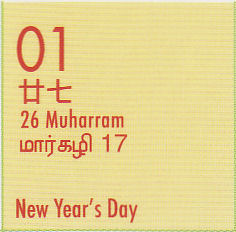Happy new multicultural year
By Murray Bourne, 01 Jan 2011
My local council gave us a 2011 desk calendar.
I thought it encapsulated how Singapore has successfully produced a multicultural society.
Here's today's entry:

We see:
- The Gregorian calendar date (established by Pope Gregory in the 16th century) for today (1st January) using Hindu-Arabic numbers (1, 2, 3, ...)
- The Chinese characters for "27", since it is the 27th day of Hiemens (the winter month). It is Chinese Year 4708.
- 26 Muharram (the first month of the Islamic year). Muslim years are 354 days long and similar to Chinese calendar in that they are based on 12 lunar months. It is currently the year 1432 A.H. in the Muslim calendar (1432 years since Muhammad emigrated from Mecca to Medina, A.D. 622)
- The Malayalam date 17 Dhanu, year 1186.
(That last one took some research and even then, it is one day out of synch with most of the Malayalam calendars I found. Perhaps my Indian readers could enlighten me.)
Singapore has put racial tolerance and harmony very high on the agenda. Respecting cultural norms, especially key festival dates, is a great place to start.
Sadly, too many countries try to destroy cultures of minorities, usually with tragic results.
Happy New Year, everyone!
See the 10 Comments below.
14 Jan 2011 at 9:42 pm [Comment permalink]
My best wishes for the New Year Murray.I thank you for the great service that you render to the mathematical world. Being 86 I never will become a mathematical giant. However, I try to absorb as much as I can. Mathematics is now so much diversified that mathematicians have to specialize. I am reading now again my book: 'The Mathematical Tourist, by Ivars Peterson. (new and udated snapshots of modern mathematics.
I went through a difficult time as my house was flooded by hurricane Nicole. Much damage to furniture, scientific books and my scriptures. I am back now and meet a new day. God bless. Johan.
15 Jan 2011 at 12:11 pm [Comment permalink]
Hi Johan and always good to hear from you.
Sorry to hear about your flooded house - I hope you have everything back in order now. All the best to you!
15 Jan 2011 at 7:45 pm [Comment permalink]
The last (fourth) one mentioned in the calender indicates that the Tamil month Markhazhi 17. It is based on Tamil calender. Not Malayalam.
I really agree with him; It is great that the country Singapore treats all the citizens equally irrespective of the race carrying forward their cultural values.
Regards,
Anand
15 Jan 2011 at 7:53 pm [Comment permalink]
??????? 17 (Maarkazhi 17) is a TAMIL date. It is not the Malayalam calendar. Tamil communities constitute a considerable percent of Singapore population. You can find Tamil script on Singapore dollar bills. There are Tamil schools also. Malayalam (??????) is an offshoot from the Tamil language.
16 Jan 2011 at 12:07 pm [Comment permalink]
I am a native speaker of Malayalam language.
I was so delighted and excited to see my mother tongue
mentioned in your News Letter of which I am
a regular reader. Very many thanks for making a reference
to this language in your column.
Malayalam is spoken mostly in Kerala State in India which is located in the south-west corner of the
Indian sub-continent. You may be surprised to know that
this land has a rich tradition in mathematics. One high
point of this tradition is the discovery of the
power series expansions of the sine and cosine
functions by Kerala mathematicians some
two centuries before these were rediscovered in Europe.
A starting point to know more about these could
be the Wikipedia article on
"Kerala school of astronomy and mathematics".
Thanks again.
16 Jan 2011 at 9:14 pm [Comment permalink]
@S Anand and ??????'s enlightening (we can't read your name without Tamil fonts!): Thanks for the information. I first assumed it was Tamil (since Tamil is one of the official languages in Singapore) but the calendars I found did not have a "17" date corresponding with 1st January. Or maybe I was looking in the wrong places.
@ Dr V N Krishnachandran: Thanks for your interesting input about the Kerala school.
Just to put my mind at rest - is the date a legitimate Malayalam date as well as Tamil?
20 Jan 2011 at 4:17 pm [Comment permalink]
Belated WISH YOU A HAPPY NEW YEAR Murray sir. Thank u for giving me the good content for me, thank u so much sir
...Rani
20 Jan 2011 at 7:33 pm [Comment permalink]
Thanks Rani - and the same to you, too!
27 Jan 2011 at 4:53 am [Comment permalink]
Thanks Murray,
You have given me a good idea for my form group to develop a calendar. We have a very mixed cultural group and I think the students will find it an interesting task.
Jane
27 Jan 2011 at 1:48 pm [Comment permalink]
Hi Jane and thanks for sharing. Yes, a lot of mathematics was developed while trying to solve real-life calendar problems, so it's a worthwhile thing to do.
I'd love to see your students' calendar when they are finished!